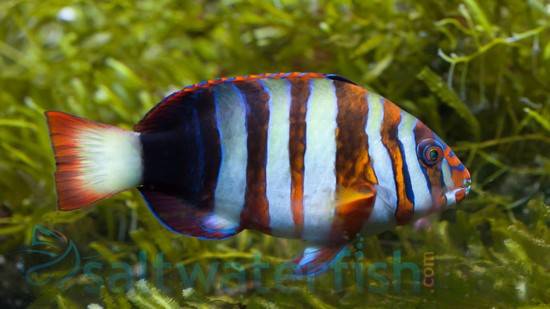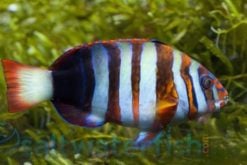Harlequin Tusk (Choerodon fasciatus) – Saltwater Aquarium Guide
Quick Stats:
- Care Level: Moderate
- Temperament: Semi-aggressive
- Diet: Carnivore
- Reef Safe: No
- Minimum Tank Size: 120 gallons
- Max Size: Up to 12 inches
- Water Parameters: Temperature: 72-78°F, pH: 8.1-8.4, Salinity: 1.020-1.025, Ammonia/Nitrite: 0, Nitrate: <30 ppm
Comprehensive Guide: Harlequin Tusk (Choerodon fasciatus)
Habitat:
The Harlequin Tusk is native to the Indo-Pacific region, particularly the Great Barrier Reef and the Coral Sea. It is commonly found in lagoons and outer reef slopes, seeking shelter among rocks and coral formations.
Reef Safe:
The Harlequin Tusk is not considered reef safe. It may nip at and potentially damage corals, clams, and other sessile invertebrates. It is best kept in a fish-only or predator tank.
Size:
The Harlequin Tusk can grow up to 12 inches long, making it a relatively large fish for a home aquarium. Ensure you have a tank that can accommodate its size.
Temperament:
The Harlequin Tusk is known for its semi-aggressive nature. It can be territorial and aggressive towards other fish, especially those of similar size and appearance.
Sexual Dimorphism:
There are no distinct visual differences between males and females of the species.
Lifespan:
The Harlequin Tusk has a lifespan of around 5-10 years when kept in proper aquarium conditions.
Diet in Aquariums:
The Harlequin Tusk is a carnivorous fish that primarily feeds on small invertebrates and crustaceans in the wild. An aquarium can be fed a varied diet consisting of high-quality frozen and live meaty foods such as shrimp, squid, and small fish.
Aquascaping Recommendations:
Provide plenty of hiding spots and caves using live rock and coral structures. The Harlequin Tusk appreciates a well-decorated tank with ample swimming space.
Captive Bred Availability:
The Harlequin Tusk is rarely available as captive-bred. Most specimens in the aquarium trade are wild-caught. It is important to source the fish responsibly from reputable suppliers.
Compatibility with Other Fish, Invertebrates, or Corals:
The Harlequin Tusk can be aggressive towards other fish, especially those of similar size and appearance. It is best kept with larger, more robust tankmates. Avoid keeping it with small, delicate fish or invertebrates that may become prey.
Five suitable tankmates for the Harlequin Tusk include:
- 1. Emperor Angelfish – They have a similar size and can hold their own against the Harlequin Tusk’s aggression.
- 2. Purple Tang – They are fast swimmers and can avoid confrontations with the Harlequin Tusk.
- 3. Foxface Rabbitfish – Their venomous spines discourage the Harlequin Tusk from attacking them.
- 4. Maroon Clownfish – They are known for their resilience and can establish their territory alongside the Harlequin Tusk.
- 5. Cleaner Wrasse – They can help keep the Harlequin Tusk’s skin free from parasites, establishing a beneficial symbiotic relationship.
Other Common Names:
The Harlequin Tusk is also known as the Harlequin Wrasse or the Hawaiian Harlequin Tusk.
Why Buy from Reefs4Less.com:
Reefs4Less.com is a trusted online retailer specializing in saltwater aquarium supplies. They offer many high-quality products, including fish, corals, and equipment. With their commitment to customer satisfaction and competitive pricing, Reefs4Less.com is a reliable choice for all your saltwater aquarium needs.
Popular Questions and Answers:
Q: Can the Harlequin Tusk be kept in a reef tank?
A: The Harlequin Tusk is not considered reef-safe as it may damage corals and other sessile invertebrates.
Q: How often should I feed my Harlequin Tusk?
A: Feed your Harlequin Tusk in small amounts multiple times daily. It is important to maintain a varied and balanced diet.
Q: Can the Harlequin Tusk change its color?
A: The Harlequin Tusk can change color depending on its mood and environment. It may display brighter colors when it feels threatened or during courtship.
Q: Does the Harlequin Tusk require a specific lighting setup?
A: While the Harlequin Tusk does not have specific lighting requirements, providing a well-lit tank with a mix of actinic and daylight spectrum lighting can enhance its colors and overall appearance.
Q: Can the Harlequin Tusk be kept with other wrasses?
A: Keeping the Harlequin Tusk with other wrasses is generally not recommended, as they may compete for territory and resources.



Reviews
There are no reviews yet.